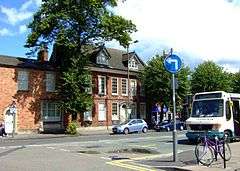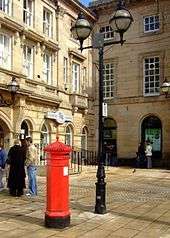William Salt Library
| The William Salt Library | |
|---|---|
 The Library in 2008 | |
| General information | |
| Type | Library |
| Architectural style | Georgian |
| Address | 19 Eastgate Street |
| Town or city | Stafford |
| Country | England |
| Coordinates | 52°48′24″N 2°06′50″W / 52.8066°N 2.1140°WCoordinates: 52°48′24″N 2°06′50″W / 52.8066°N 2.1140°W |
| Construction started | 1730 |
| Completed | 1735 |
| Owner | Trustees of the William Salt Library |
| Designations | Grade II* listed |
| Website | |
|
www | |

The William Salt Library is a library and archive, in Stafford, Staffordshire. Supported by Staffordshire County Council,[1] it is a registered charity,[2] administered by an independent trust in conjunction with the Staffordshire & Stoke-on-Trent Archive Service,[1] which also operates the county archives from an adjacent building.
The core of the library is the large collection of printed books, pamphlets, manuscripts, drawings, watercolours, and transcripts built up by William Salt (1808–1863), a London banker.[1] Collected during Salt's lifetime, the collection was donated to Staffordshire after his death, and the library opened in 1872.[3] It moved to its present Grade II* listed building in Eastgate Street in 1918. The Eastgate Street building was a house completed in 1735.[4][4] The library continues to collect and preserve printed material relating to Staffordshire and represents a major source for local and family history in Staffordshire. The library's holdings are available for consultation by the public free of charge.[1]
The library is supported by the Friends of the William Salt Library.[5][6] As well as raising funds for the library to enable it to purchase items for the collection, the Friends also help in practical ways, such as packaging and cleaning items in the collection.[6]
Colin Dexter undertook much of the research for his eighth Inspector Morse novel The Wench is Dead (published in 1989) at the library. Dexter recalled that he spent "a good many fruitful hours in the library" consulting contemporary newspaper reports of the murder of Christina Collins, on which the novel was based.[7] He subsequently became patron of the library's 135th anniversary fund-raising appeal.[7]
References
- 1 2 3 4 "William Salt Library, Stafford". Staffordshire County Council. Retrieved 17 November 2012.
- ↑ Charity Commission. William Salt Library, registered charity no. 528570.
- ↑ "William Salt, 1808-1863". Staffordshire County Council. Retrieved 17 November 2012.
- 1 2 "William Salt Library - Stafford - Staffordshire - England". British Listed Buildings. Retrieved 17 November 2012.
- ↑ Staffordshire Heritage Group, Friends of The William Salt Library
- 1 2 "Friends of the William Salt Library". Staffordshire County Council. Retrieved 17 November 2012.
- 1 2 William Salt Library
External links
- The William Salt Library, Stafford
- Staffordshire & Stoke On Trent Archive Service
- Friends of the William Salt Library